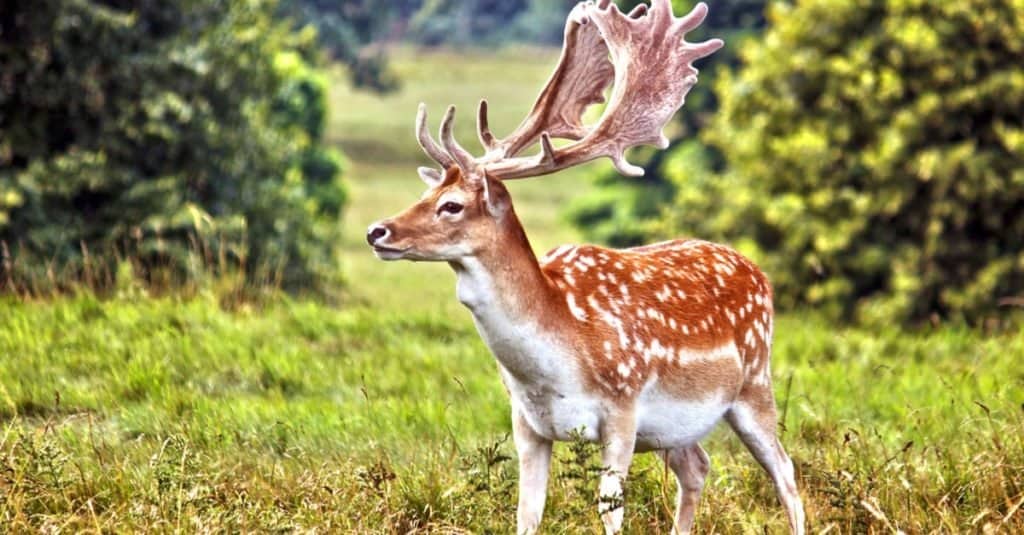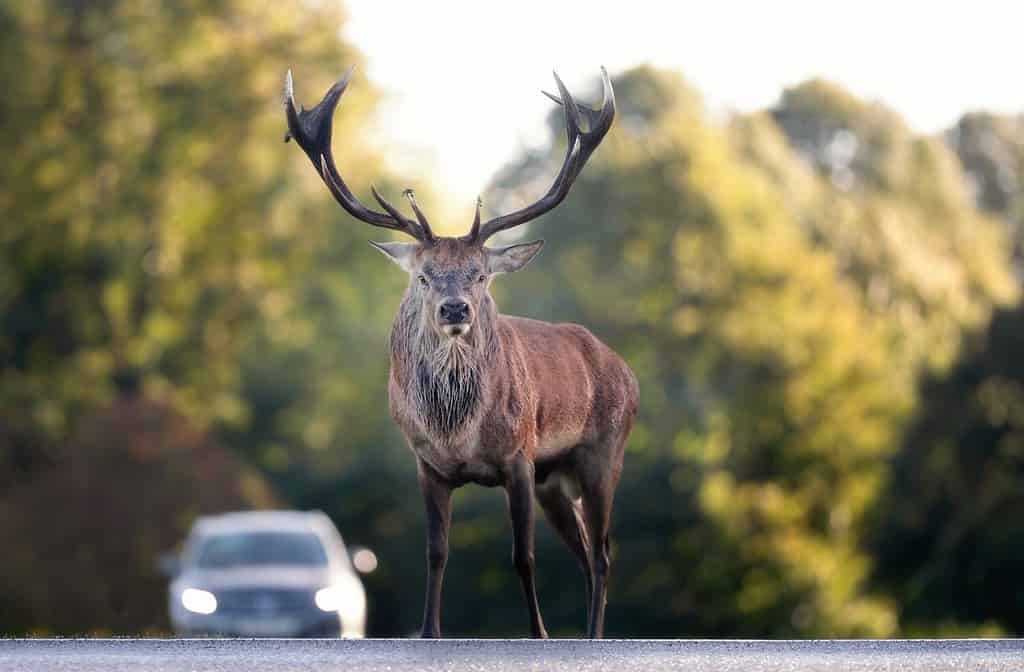England has six species of deer, of which only two are native. The total population has increased in recent years, but exactly how many deer are in England and across the United Kingdom? Discover how many deer roam these green lands and which species top the chart.
How Many Deer Are There in England?
Research from The Deer Initiative suggests England’s deer population is at its highest for at least 1,000 years, with estimates of up to two million deer living in the UK’s countryside and partially urban areas. That’s a large increase from just 450,000 deer in the 1970s. The population jump is down to milder winters, an abundance of food, and no predators.

England’s deer population has boomed over the past few decades.
©Neil Clarke/Shutterstock.com
Types of Deer in England
Six deer species live in England, but only the roe deer and red deer are indigenous. Fallow deer were reintroduced by the Romans in 44 A.D. and by the Normans after their conquest in 1066. Experts believe fallow deer once lived in England but died out during the last ice age.
The three Asiatic species brought over in the 19th and 20th centuries are the Chinese water deer, sika deer, and Reeves’ muntjac deer.
All six deer species live wild in England. The Normans released fallow deer to hunt, while the three Asian species escaped parks and private collections.
Below, we’ll look at the number of England’s deer per species.
Red Deer
Red deer are England’s (and the UK’s) largest wild mammals on land. 30% of the European red deer population resides in the UK.
These native deer reach 2.9 feet at the shoulder and live for 25 years. Stags carry magnificent branched antlers that reach 3.2 feet across and shed them every winter. In spring, a single (or two in areas with lots of food) spotty fawn is born to a doe. Does live in herds, and in the fall rutting season, males compete over the herd’s mating rights.
Red deer have reddish-brown fur, which fades to gray over winter. They eat grasses, rushes, tree bark, leaves, and heather. Hillsides, moors, and forests are their preferred habitats. Scotland’s conifer plantations house a large population.
The UK has a population of at least 350,000 red deer, and most reside in Scotland. England’s New Forest, Hampshire, Cumbria, East Anglia, and Peak District house around 56,000 red deer. Fewer than 500 live in Wales, and even fewer across Northern Ireland.

The red deer is England’s largest terrestrial mammal.
©Giedriius/Shutterstock.com
Roe Deer
England’s second native deer is the roe deer. This beautiful mammal eats grasses, wildflowers, tree bark, brambles, ivy, ferns, and acorns. The vast majority live in forest clearings and low woodlands.
This is England’s most common deer species. They live in the countryside and semi-urban areas, reaching the size of a goat or large dog.
Brown, sandy-colored fur that changes to gray-brown covers their body except for a white patch on the rump. White chins, black noses, and a small tufted tail make roe deer unmistakable in the countryside!
Stags display short, three-pointed antlers and do give birth to fawns in springtime. Solitary creatures, they are shy and easily spooked.
The UK’s rising roe deer population is at least half a million, with 324,000 spread across England’s southern and midland counties, including Cornwall, Essex, Gloucestershire, Suffolk, and Norfolk. Recently, a roe deer population has begun to establish itself in Wales. No roe deer reside in Ireland.

Roe deer are the most common deer species in England.
©WildMedia/Shutterstock.com
Fallow Deer
Before the last ice age, fallow deer roamed England, but they didn’t make it through the huge climate changes. However, when the Romans arrived in Britain in 44 AD, they brought fallow deer, and when the Normans invaded in 1066, more fallow deer were introduced to the wild for game hunting.
Today, a large population of fallow deer is widespread throughout England and the UK. These attractive deer have reddish-brown summer fur, followed by a thicker grey coat in winter. All year, fallow deer display back spots and a dark stripe on their tails. Males’ distinctive palmate antlers shed in late spring.
Fallow deer run in herds of around 50, in unisex groups, that meet in the fall to mate. They eat tree leaves, rushes, and grass, plus berries, acorns, and heather from woodlands, meadows, and marshland. England boasts many manor house deer parks and fallow deer are their most popular species.
Across the UK, an estimated 262,000 fallow deer live wild and in managed parkland. The majority live in England and parts of Ireland and Wales.

Fallow deer were reintroduced to England by invading Romans and Normans.
©WildMedia/Shutterstock.com
Muntjac Deer
Muntjac is the most common Asiatic deer species in England. Introduced in 1838 to Woburn Park in Bedfordshire by John Russell Reeves, some escaped and established a large population across England.
These are the smallest of England’s deer, only reaching 1.5 feet (the size of a retriever dog.) Originally from southeast China, they eat woodland greenery, including leaves, grasses, sedges, acorns, berries, and tree bark. Muntjacs prefer the safety of dense understorey forests, but they’re known to enter urban gardens to strip veggie patches, too.
Deep red to brown, these little deer have a white stripe on their tails’ underside that they raise in alarm. Males display short, pointed antlers that point backward and large canine teeth used for fighting. Both genders have dark eye pouches and make dog-like barks.
Around 123,000 muntjac deer live wild in the UK, with most in southern and eastern England. They’re considered invasive species, so if captured, they cannot be returned to the wild. England’s muntjac deer population is very difficult to estimate because they can live undetected in small woodland copses and large gardens.

Reeves muntjac deer are an invasive species in England. It’s illegal to release one into the wild.
Sika Deer
Another Asiatic deer species resident in England is Japan and Taiwan’s sika deer. In 1860, sika deer were proudly displayed in upper-class deer park collections, but they escaped and established local populations that spread over England.
Sika deer have glossy brown coats with summer spots that turn deep gray in winter. They reach just a shade under four feet tall, and stags have four-point antlers that distinguish them from muntjacs.
Secretive sika deer are rarely seen in England. They graze in thick woodland in the day and only move to open space at dusk to forage sedge, heather, grasses, bark, and fungi. Most live in coniferous woodlands and heaths.
In the UK, sika deer roam wild and in deer parks. Most reside in Scotland, but around 16,000 live in England, most notably Hampshire and Dorset.

Asiatic sika deer arrived in the UK in 1860 and escaped into the wild.
©iStock.com/Elena Tcykina
Chinese Water Deer
Northeast China’s Chinese water deer first appeared in England’s London Zoo in 1873. In 1929, Chinese water deer escaped Whipsnade Zoo and Woburn Park, and a small population now lives wild, mostly in East Anglia and the Midlands.
This light-colored, elusive deer lives near water sources such as river shores, reed beds, fenlands, and lakeside forests, where it eats aquatic vegetation, willow leaves, mosses, and sedge grass. They don’t have antlers, but an unmissable feature is a pair of two-to-three-inch long canine teeth that males use to fight in the rutting season. Of course, this has led to the nickname “vampire deer.”
Experts think England’s 1,500-strong (plus 600 in parks and zoos) Chinese water deer comprises 10% of the world’s population.

Chinese water deer have distinctive six-inch-long canine teeth.
©Erni/Shutterstock.com
Is Deer Hunting Legal in England?
In the 19th and 20th centuries, horseback hunting with staghounds was a popular upper-class sport. However, in 2005, hunting deer with hounds was made illegal. Currently, only two hounds are allowed to flush out deer for marksmen to shoot immediately.
Deer are hunted in England, but a police-licensed firearm and ownership (or lease) of land the deer resides on are both required, so this means it’s not a common pastime.
Obtaining a firearms license in England is difficult, so few people hunt England’s deer. The majority of hunters are farmers or gamekeepers carrying out agreed culls with licensed firearms. Around 350,000 deer are annually culled in England.
In general, hunting in England is restricted and subject to several laws, including the Wildlife and Countryside Acts of 1981 and the 2004 Hunting Act. Hunting any mammal with a bow is illegal.

To hunt deer in England, a police-issued firearms license is required.
©Robert Schneider/Shutterstock.com
Where Do They Live?
In England, deer live in parks, where they’re managed by gamekeepers, and native or escaped deer live wild in England’s woodland, forests, and heathlands.
Most species prefer the cover of trees, understorey canopies, and thickets, only leaving to graze forest clearings or field edges at dawn and dusk.
What Do They Eat?
Forest greenery and farmers’ crops keep wild deer well-fed in England. All deer are capable of surviving on very little vegetation.
In summer, deer eat grasses, sedges, flowers, nuts, and berries, then in winter, they strip tree bark or graze cropland.
What Preys on England’s Deer?
Very few animals prey on England’s deer, and that’s one of the reasons why the population is increasing.
In the past, wolves and lynx hunted deer, but those predators don’t exist in England now. While tiny fawns may fall prey to an occasional fox or domestic dog, adult deer have no predators. Hundreds of years ago, deer provided food for humans, too, but laws now prevent that without specific licenses.

England’s deer have no predators because native wolves and lynx were hunted to extinction.
©Alan Jeffery/Shutterstock.com
The photo featured at the top of this post is © Edgar Smislov/Shutterstock.com
Thank you for reading! Have some feedback for us? Contact the AZ Animals editorial team.







